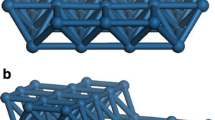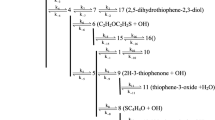Abstract
The deep oxidation of benzene by preadsorbed hydroxyl on the Pt(111) surface has been characterized using temperature-programmed reaction spectroscopy. A mechanism for benzene oxidation in the presence of coadsorbed water has been developed based on these experiments. Reaction-limited carbon dioxide and water are formed over the temperature range 330–530 K, indicating oxydehydrogenation and skeletal oxidation are occurring over this temperature range. Oxidation of benzene has been compared on the oxygen-covered Pt(111) surface with and without coadsorbed water. With preadsorbed hydroxyl, the yield of water at low-temperatures is increased, and the yield of carbon dioxide is increased. The temperature ranges for carbon dioxide and water formation above 300 K are increased by 30 K when water is coadsorbed with atomic oxygen to form hydroxyl. These results clearly suggest that hydroxyl enhances oxydehydrogenation below 300 K, which results in the formation of different dehydrogenated intermediates with increased activation energy for oxidation during the reaction. Taken together these kinetic and mechanistic results provide a clear description of the reactivity of hydroxyl during benzene deep oxidation on the Pt(111) surface.
Similar content being viewed by others
References
J.M. Thomas and W.J. Thomas, Principles and Practice of Heterogeneous Catalysis (VCH Publishers, Inc., New York, 1997).
K. Sakai and K. Matsumoto, J. Mol. Catal. 67 (1991) 7.
T. Miyake, M. Hamada, Y. Sasaki and M. Oguri, Appl. Catal. A 131 (1995) 33.
C.M. Marks and L.D. Schmidt, Chem. Phys. Lett. 178 (1991) 358.
C.E. Mooney, L.C. Anderson and J.H. Lunsford, J. Phys. Chem. 95 (1991) 6070.
J. Bergeld, B. Kasemo and D.V. Chakarov, Surf. Sci. 495 (2001) L815.
A. Manasilp and E. Gulari, Appl. Catal. B 37 (2002) 17.
X.-Q. Gong, P. Hu and R. Raval, J. Chem. Phys. 119 (2003) 6324.
G.A. Somorjai Introduction to Surface Chemistry and Catalysis (John Wiley &; Sons, Inc., New York, 1994).
G.B. Fisher and B.A. Sexton, Phys. Rev. Lett. 44 (1980) 683.
J.R. Creighton and J.M. White, Surf. Sci. 122 (1982) L648.
K. Bedürftig, S. Völkening, Y. Wang, J. Wintterlin, K. Jacobi and G. Ertl, J. Chem. Phys. 111 (1999) 11147.
A.P. Setsonen, Y. Zhu, K. Bedürftig and H. Over, J. Am. Chem. Soc. 123 (2001) 7347.
M. Chen, S.P. Bates, R.A. van Santen and C.M. Friend, J. Phys. Chem. B 101 (1997) 10051.
M. Nagasaka, I. Nakai, H. Kondoh, T. Ohta and V. Carravetta, Chem. Phys. Lett. 375 (2003) 419.
J.T. Ranney, S.R. Bare and J.L. Gland, Catal. Lett. 48 (1997) 25.
H. Guo and F. Zaera, Surf. Sci. 524 (2003) 1.
S. Lehwald, H. Ibach and J.E. Demuth, Surf. Sci. 78 (1978) 577.
M.-C. Tsai and E.L. Muetterties, J. Am. Chem. Soc. 104 (1982) 2534.
J.A. Horsley, J. Stöhr, A.P. Hitchcock, D.C. Newbury, A.L. Johnson and F. Sette, J. Chem. Phys. 83 (1985) 6099.
J.M. Campbell, S. Seimanides and C.T. Campbell, J. Phys. Chem. 93 (1989) 815.
A. Wander, G. Held, R.Q. Hwang, G.S. Blackman, M.L. Xu, P. de Andres, M.A. Van Hove and G.A. Somorjai, Surf. Sci. 249 (1991) 21.
P.S. Weiss and D.M. Eigler, Phys. Rev. Lett. 71 (1993) 3139.
C. Xu, Y.-L. Tsai and B.E. Koel, J. Phys. Chem. 98 (1994) 585.
S. Haq and D.A. King, J. Phys. Chem. 100 (1996) 16957.
M. Saeys, M.-F. Reyniers, G.B. Marin and M. Neurock, J. Phys. Chem. B 106 (2002) 7489.
A.L. Marsh and J.L. Gland, Surf. Sci. 536 (2003) 145.
A.L. Marsh, D.J. Burnett, D.A. Fischer and J.L. Gland, J. Phys. Chem. B 107 (2003) 12472.
J.L. Gland, B.A. Sexton and G.B. Fisher, Surf. Sci. 95 (1980) 587.
D.M. Haaland, Surf. Sci. 102 (1981) 405.
Y. Suda, Langmuir 4 (1988) 147.
S. Tsuzuki, K. Honda, T. Uchimaru, M. Mikami and K. Tanabe, J. Am. Chem. Soc. 122 (2000) 11450.
Author information
Authors and Affiliations
Corresponding author
Rights and permissions
About this article
Cite this article
Marsh, A.L., Gland, J.L. Effect of Coadsorbed Water on Deep Oxidation Mechanisms: Temperature-Programmed Reactions of Benzene and Hydroxyl on the Pt(111) Surface. Catalysis Letters 93, 165–170 (2004). https://doi.org/10.1023/B:CATL.0000017071.15340.46
Issue Date:
DOI: https://doi.org/10.1023/B:CATL.0000017071.15340.46




